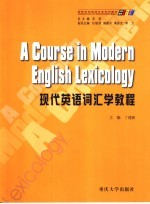图书介绍
现代英语词汇学教程pdf电子书版本下载

- 丁建新主编 著
- 出版社: 重庆:重庆大学出版社
- ISBN:7562432104
- 出版时间:2004
- 标注页数:164页
- 文件大小:14MB
- 文件页数:175页
- 主题词:英语-词汇-高等学校-教材
PDF下载
下载说明
现代英语词汇学教程PDF格式电子书版下载
下载的文件为RAR压缩包。需要使用解压软件进行解压得到PDF格式图书。建议使用BT下载工具Free Download Manager进行下载,简称FDM(免费,没有广告,支持多平台)。本站资源全部打包为BT种子。所以需要使用专业的BT下载软件进行下载。如 BitComet qBittorrent uTorrent等BT下载工具。迅雷目前由于本站不是热门资源。不推荐使用!后期资源热门了。安装了迅雷也可以迅雷进行下载!
(文件页数 要大于 标注页数,上中下等多册电子书除外)
注意:本站所有压缩包均有解压码: 点击下载压缩包解压工具
图书目录
1 Introduction:Word,Vocabulary and Lexicology 1
1.1 The notion of'word' 1
1.1.1 Do words exist? 1
1.1.2 Bloomfield's definition of word 2
1.1.3 Characteristics of words 4
1.2 The organization of English vocabulary 5
1.2.1 The syntagmatic and paradigmatic relations 5
1.2.2 Word classes 7
1.2.3 Lexical fields 9
1.3 Lexicology and other levels of linguistic analysis 11
1.3.1 Lexicology and phonology 11
1.3.2 Lexis and grammar:two forms of patterning 12
1.3.3 Lexicology and semantics 14
1.4 Summary 15
Exercises 16
2 English Vocabulary:A Historical Perspective 18
2.1 The Indo-European language family 18
2.2 The English people and the English language 19
2.3 The development of English vocabulary 22
2.3.1 The Old English period 22
2.3.2 The Middle English period 24
2.3.3 Modern English period 26
2.4 Summary 30
Exercises 31
3 Borrowing as a Source of English Word-Stock 32
3.1 The size of English word-stock 32
3.2 The native words of the English language 33
3.3 Borrowing:an overview 35
3.4.1 Latin borrowings 36
3.4 Major sources of borrowing 36
3.4.2 Scandinavian influences 38
3.4.3 French loan words 39
3.4.4 Greek adoptions 41
3.5 Minor sources of borrowing 42
3.6 Influences of borrowings 43
3.7 Summary 44
Exercises 45
4 Major Processes of Word Formation 47
4.1 Morpheme,root and affix 47
4.2 Derivation and compounding 49
4.3 Prefixation 50
4.4 Suffixation 53
4.5.1 Basic features of compounds 56
4.5 Compounding 56
4.5.2 Classification of compounds 57
4.5.3 The syntax of compounds 59
4.6 Summary 62
Exercises 62
5 Minor Processes of Word Formation 63
5.1 Blending 63
5.2 Back-formation 65
5.3 Initialism 67
5.3.1 Abbreviation 67
5.3.2 Acronyms 68
5.4 Clipping 68
5.5 Aphesis 70
5.6 Analogy 70
5.7 Reduplication 71
5.6.1 Single words formed by analogy 71
5.6.2 Phrases formed by analogy 71
5.8 Words from proper names 72
5.8.1 Words from names of people 73
5.8.2 Words from names of places 73
5.8.3 Words from names of books 74
5.8.4 Words from trademarks 75
5.9 Summary 75
Exercise 76
6 Word Meaning and Meaning Relations 78
6.1 Conventionality versus motivation 78
6.2 Meanings of meaning 80
6.3 Four kinds of meaning 81
6.3.2 Denotation and sense 82
6.3.1 Denotation and reference 82
6.3.3 Denotation and connotation 83
6.4 Meaning relations 84
6.4.1 Synonymy 84
6.4.2 Antonymy 89
6.4.3 Hierarchical meaning relations—hyponymy and meronymy 93
6.5 Semantic field and componential analysis 96
6.6 Word meaning and context 96
6.6.1 Types of context 97
6.6.2 The role of context 99
6.7 Summary 103
Exercises 103
7.1 The OED model 105
7.1.1 Core vocabulary 105
7 Words in Use 105
7.2 The register model 107
7.2.1 Dialects 107
7.2.2 Diatypes 115
7.3 Summary 121
Exercises 122
8 Multi-word Lexical Units:Collocation,Lexical Phrase and Idiom 123
8.1 The research tradition of prefabricated language 123
8.2 Collocations 125
8.2.1 Meaning by collocation 125
8.2.2 The typology of collocations 126
8.2.3 Investigating lexis:corpus approach to collocations 127
8.3 Lexical phrases 129
8.3.1 The definition of lexical phrase 129
8.3.2 Functions of lexical phrases 130
8.3.3 Lexical phrases and language teaching 132
8.4 Idioms 133
8.4.1 The definition and main features of idioms 133
8.4.2 The categorization of idioms 134
8.4.3 The meaning of idioms 135
8.5 Implications of linguistic prefabrication 136
8.6 Summary 137
Exercises 138
Appendix 1 Common Prefixes 140
Appendix 2 Common Suffixes 143
Appendix 3 Common Roots 145
Appendix 4 Lexicology Terms(English-Chinese) 149
Key to Exercises 152
References 160